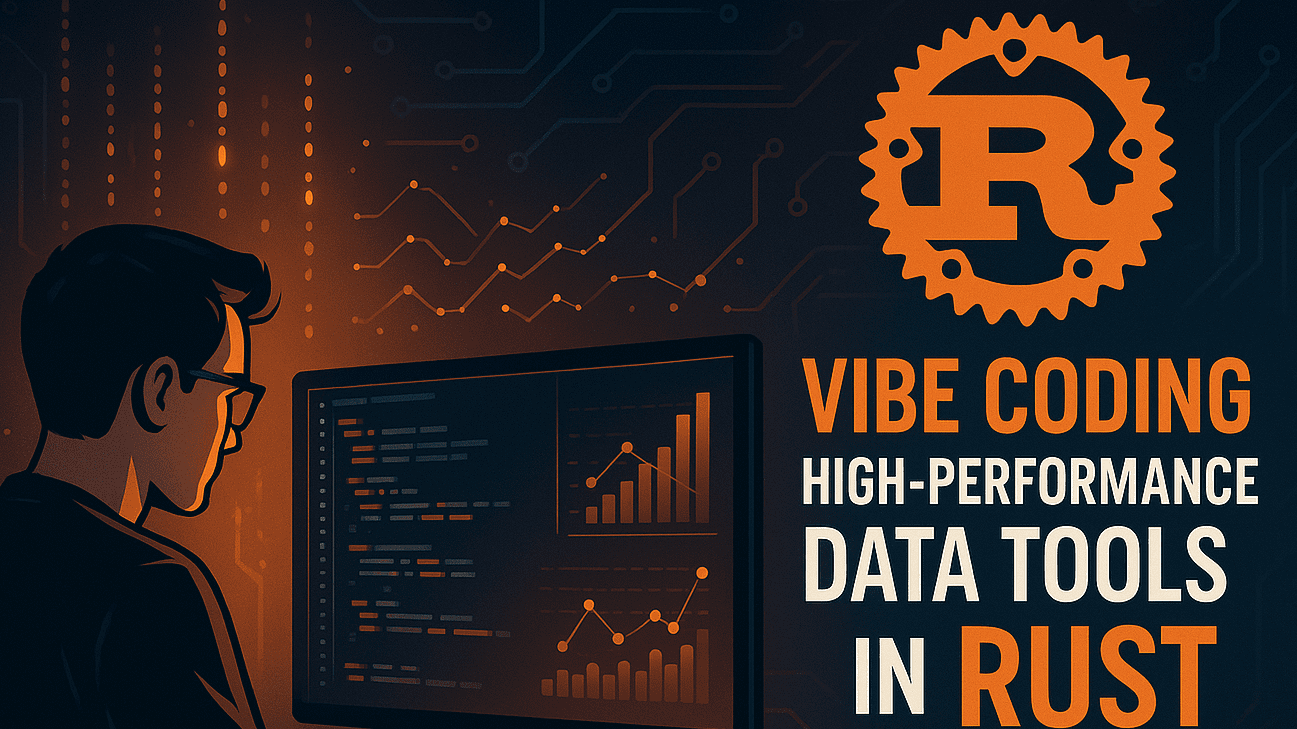Blog
Vibe Coding High-Performance Data Tools in Rust

Introduction to High-Performance Data Tools in Rust
In today’s fast-paced digital landscape, the demand for high-performance data tools is at an all-time high. Rust, a systems programming language, has emerged as a popular choice for building efficient, concurrent, and reliable applications. This blog post explores how Rust is transforming the development of high-performance data tools, offering unmatched speed and safety.
The Rise of Rust
Rust is known for its combination of speed and safety, making it ideal for performance-critical applications. Unlike many other programming languages, Rust emphasizes memory safety without compromising on performance. This unique feature allows developers to write code that is not only efficient but also free from common programming pitfalls such as null pointer dereferencing and data races.
Advantages of Rust for Data Tool Development
-
Memory Safety and Performance: Rust’s ownership model ensures that memory is managed effectively and safely. This leads to fewer crashes and reduced runtime errors, which are crucial for data-intensive applications.
-
Concurrency Without Fear: Rust’s approach to concurrency allows developers to harness multiple cores without the sluggishness associated with traditional threading models. This is particularly important for data tools that handle large datasets and require parallel processing capabilities.
- Rich Ecosystem and Libraries: The Rust community has developed a vast array of libraries and frameworks that are designed for high-performance data processing, including libraries for numerical computations, data manipulation, and machine learning.
Building High-Performance Data Tools
When developing data tools in Rust, several key principles and tools can enhance performance and functionality.
Efficient Data Structures
Choosing the right data structures is essential for optimizing performance. Rust provides a range of built-in collections, such as vectors and hash maps, that are designed for efficiency. Developers can also create custom data structures to suit specific requirements, ensuring that applications are optimized for speed and memory usage.
Leveraging Parallelism
To maximize throughput, developers can take advantage of Rust’s concurrency features. Libraries like Rayon enable easy parallelism by allowing operations on collections to be performed concurrently. This is particularly beneficial for tasks like data processing and analysis, where operations can be parallelized effectively.
Asynchronous Programming
Rust’s asynchronous programming model allows developers to write non-blocking code that can handle multiple tasks simultaneously. This is especially useful in data tools where I/O operations can become bottlenecks. By using asynchronous libraries like Tokio, developers can ensure that their applications remain responsive even when processing large volumes of data.
Case Studies of Rust in Data Tool Development
To illustrate the capabilities of Rust in building high-performance data tools, let’s explore a few notable projects.
Data Analysis Frameworks
Many organizations are turning to Rust to develop data analysis tools that require high levels of performance and reliability. For example, frameworks like Polars offer a fast DataFrame library that provides functionality similar to that of Python’s Pandas but with Rust’s added performance benefits. Polars is designed for speed and leverages Rust’s ability to handle large datasets efficiently.
Machine Learning Libraries
The rise of machine learning has led to the development of high-performance libraries built on Rust. Libraries such as Tch-rs, a Rust binding for the popular libtorch, allow developers to build and train neural networks with impressive speed. By harnessing Rust’s performance capabilities, machine learning tools can run faster, enabling quicker iterations and faster deployment of models.
Web Assembly for Data Processing
Rust’s support for WebAssembly (Wasm) allows developers to run high-performance data tools directly in web browsers. This opens up new possibilities for interactive data visualization and real-time data processing on the client side, making data tools more accessible and engaging for users.
Best Practices for Developing Data Tools in Rust
To create robust and efficient data tools using Rust, consider implementing the following best practices:
Prioritize Testing and Benchmarking
High-performance tools must be rigorously tested to ensure that they meet performance benchmarks. Rust’s built-in testing framework enables developers to write unit and integration tests easily. Regular benchmarking can help identify performance bottlenecks, guiding optimizations before deployment.
Use Profiling Tools
Take advantage of profiling tools to analyze your application’s performance. Rust offers several profiling libraries that enable developers to gain insights into where their code may be lagging. This allows for targeted optimization, ensuring that the final product meets the necessary performance criteria.
Embrace Community Contributions
The Rust community is active and continuously growing. Engaging with the community through forums, conferences, and open-source contributions can provide valuable insights and best practices. Utilizing community-developed libraries can also save time and enhance your project’s overall quality.
Future Trends in Rust and Data Tools
As Rust continues to mature, several exciting trends are emerging in the realm of data tool development.
Increased Adoption in Enterprises
More companies are recognizing the benefits of Rust in building high-performance applications. As Rust gains traction in enterprise settings, we can expect to see a rise in commercially available data tools built on its robust framework.
Expansion of Machine Learning Capabilities
As data science continues to evolve, the need for efficient machine learning tools will grow. Rust’s capabilities will likely lead to the development of new libraries that further enhance the speed and efficiency of machine learning workflows.
Enhanced Interoperability
As Rust becomes more prevalent, developers will work towards improving interoperability with other programming languages, allowing for seamless integration of Rust-based tools with existing systems. This could lead to a broader adoption across varied technology stacks.
Conclusion
Rust is transforming the landscape of high-performance data tools, offering unparalleled speed and safety. Its unique features make it an excellent choice for developers aiming to create efficient, reliable applications in today’s data-driven world. Whether you are building data analysis frameworks, machine learning libraries, or interactive web applications, Rust provides a solid foundation for delivering high-performance solutions. As the language continues to evolve, it is poised to play a critical role in the future of data tool development.
